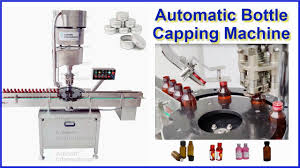Capping machines are essential for sealing bottles across industries like food, beverage, cosmetics, and pharmaceuticals. Choosing the right capping equipment improves packaging efficiency, prevents leaks, and ensures product integrity. Below, we explore the most common types of capping machines and their applications.

1. Chuck Capping Machines
How it Works:
Uses a chuck head to apply torque and tighten caps onto containers.
Best For:
- Screw caps, metal caps, and plastic caps
- Medium to high production lines
- Bottles with consistent cap sizes
Pros:
- High torque precision
- Versatile for different industries
- Minimal spillage
2. Spindle Capping Machines
How it Works:
Multiple spinning disks (spindles) apply and tighten the cap as the bottle moves through the machine.
Best For:
- Plastic screw caps
- Continuous production lines
- Mid to high-speed operations
Pros:
- No need to stop bottles
- Can handle a wide range of bottle sizes
- Easily integrated into existing lines
3. Snap Capping Machines
How it Works:
Applies downward pressure to “snap” a cap into place, often used for caps that don’t require screwing.
Best For:
- Snap-on caps
- Cosmetic, dairy, and water bottles
Pros:
- Simple mechanism
- Gentle on containers
- Cost-effective for low to medium volumes
4. ROPP Capping Machines (Roll-On Pilfer Proof)
How it Works:
Rolls threads onto aluminum caps to seal them tightly to the bottle neck.
Best For:
- Wine, spirits, and pharmaceutical products
- Tamper-evident caps
Pros:
- High security
- Ideal for non-refillable packaging
- Professional appearance
5. Cap Pressing Machines
How it Works:
Pushes the cap onto the container without rotation, often using pneumatic pressure.
Best For:
- Push-on caps or corks
- Glass bottles and tubes
Pros:
- Consistent pressure application
- Great for delicate or irregular bottles
6. Automatic vs. Semi-Automatic vs. Manual Capping Machines
| Type | Ideal For | Output Speed |
|---|---|---|
| Manual | Small-scale, lab use | Low |
| Semi-Automatic | Small to mid-scale production | Moderate |
| Automatic | Large-scale production lines | High |
Choosing the Right Capping Machine
When selecting a capping machine, consider:
- Cap type and size
- Bottle shape and material
- Production volume
- Integration with existing lines
- Budget and automation needs
A proper match will reduce downtime, improve packaging quality, and increase production efficiency.
Conclusion
Capping machines come in various types, each tailored for specific packaging needs. From high-speed spindle cappers to precise chuck machines or tamper-proof ROPP systems, the right choice depends on your cap style, bottle design, and production requirements. Investing in the right machine ensures better sealing, enhanced productivity, and improved customer satisfaction.